








Welcome to Between Spheres, our Department magazine. The name reflects the interdisciplinary nature of the research and teaching we do in Earth and Space Sciences: foundational knowledge and discovery in areas that are often at the interfaces between the geosphere, biosphere, cryosphere, hydrosphere, and atmosphere of Earth, other planets, and the space environment. We intend to produce this magazine annually, along with shorter quarterly reports, as a way to share updates and exciting news.

The COVID-19 pandemic was a major challenge for our faculty, staff, and students, and we continue to feel the consequences. Not all the impacts have been negative: we have all learned that it is possible to do much of our work remotely, and the ability to work from home (or abroad) has made it easier to schedule meetings, reduce time wasted commuting, and to keep in touch with both colleagues and families when we are in the field. Yet, we have also re-learned the importance of in-person interactions: there is simply no substitute for being physically present in the lab, the classroom and the field. This has inspired us to redouble our efforts to make our department more accessible, whether through broader recruitment efforts or through changes in the way we teach, particularly in the field (see page 10).
I have been impressed how well our students and faculty have continued to succeed in their teaching and research endeavors, despite the challenges. Exceptional research is being conducted by undergraduates and graduates, and our students are leading meaningful outreach activities within the broader Seattle community and beyond. Their efforts (see pages 14, 28, and 32) demonstrate an understanding of the importance of inspiring the young people who will become the next generation of scientists, policy makers, and leaders.
Re-engaging with our supporters and the broader ESS community is a significant priority for this year and beyond. Such efforts are made increasingly possible through the hire of a new ESS Advancement Officer in the College, Eryn Boyles-Ilk, and a new communications specialist, Summer Caton, in the Department. We have also established an Alumni Relations Committee, tasked with outlining specific priorities, goals, and recommendations through the creation of an Alumni Engagement Strategic Plan, which will allow us to better sustain these efforts over the coming years. Also in support of these efforts, we
launched a new Department website in May, which features a new design, stunning photos and videos by members of our community, and updated and easyto-locate information. Please browse the website at ess.uw.edu. Be sure to check out the alumni section, and consider submitting a highlight (whether about yourself, or someone you know).
Perhaps the most noteworthy department accomplishment has been the successful hiring of nine new faculty members over the last three years. This marks a major investment in the continued excellence of our department and programs, and I have enjoyed working with our new Dean of the College of the Environment, Maya Tolstoy, in making our strategic hiring goals a reality. Our new cohort of faculty, the most diverse in the history of our department, will contribute to our community in incalculable ways, from filling teaching gaps in our curriculum, to inspiring our students with innovative teaching, to leading groundbreaking research. We are proud, in this issue of Between Spheres, to formally introduce these new faculty to our community.
We are already a highly successful department that makes major contributions to science, with unambiguous benefits to our state, our nation, and our home planet. We have an opportunity, buoyed by the enthusiasm and energy of our new faculty in particular, to be even better. To this end, I consider it my primary job as Chair to ensure that all our newest faculty have the support that they need, whether through adequate staffing, functioning and clean laboratories, sensible allocation of space, and clearly defined expectations coupled with supportive mentoring.
The mission of our department is the same as it has always been, only better: to advance fundamental scientific knowledge, to provide challenging and supportive learning experiences, to engage with society to increase science literacy, and to increase access and reduce barriers to participation. You can read about some of the things we are doing in each of these areas in this inaugural issue of Between Spheres. And if you have ideas about how you can help, we look forward to hearing from you.
Eric J. Steig, Ben Rabinowitz Professor and ChairRobert Winglee, Professor and former Chair of Earth and Space Sciences, passed away unexpectedly on Dec. 24, 2020, after suffering a heart attack at the age of 62. His nearly 30-year UW career spanned research in space plasma physics, magnetospheric physics, advanced propulsion and engineering, as well as educational outreach to underserved and underrepresented communities across this country.
Professor Winglee published nearly 150 research articles on topics ranging from solar winds to plasma propulsion. Discover magazine granted him a 2001 Award for Technological Innovation for a project to develop a plasma-powered spacecraft. His research efforts were featured on the Discovery Channel’s “Science of Star Wars” in 2005, and “Mars Rising” in 2007.
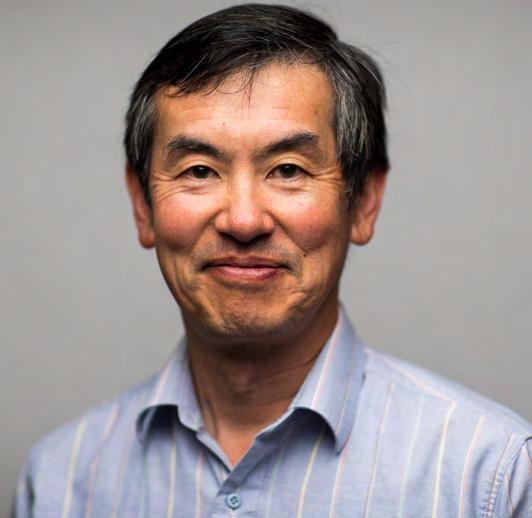
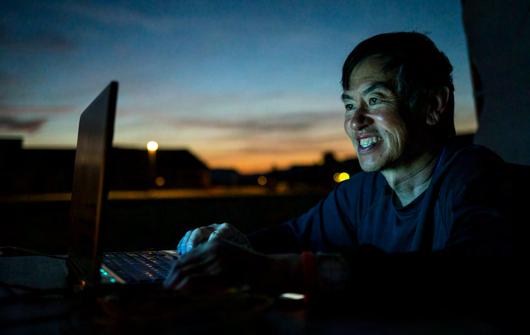
In addition to research, Robert was a devoted teacher who provided both theoretical education and practical experience. He was loved by his students for his attitude of always supporting them if they had an idea and a plan.
More recently, Robert mentored a UW student team that designed and built a miniature satellite, called a CubeSat. It launched in 2019 and began orbiting Earth in January 2020. This was the first student-built satellite to be launched in Washington

State. He also led summer exploration seminars to his native Australia, where he took numerous students into the Outback to study geology and biology.
Winglee became director of the Washington NASA Space Grant Consortium in 2007. In 2016 he established the NASA-sponsored Northwest Earth and Space Sciences Pipeline, which he also directed, to bring STEM outreach to underserved communities. He made STEM more approachable to students by emphasizing that anyone can be a scientist.
The ESS rock sample prep lab provides facilities and equipment for petrographic and geochemical sample preparation, critical infrastructure for many of our faculty and students. The lab, located in 39 Johnson Hall, has rock saws, a jaw crusher and disk mill for rock grinding, a Wilfley table for heavy mineral separation, and a full range of equipment for cutting and polishing petrographic thinsections. Much of the lab’s equipment has been in use for decades and had fallen into disrepair. It will be replaced in Fall 2023, with funding from a Student Technology Fee grant, thanks to the efforts of ESS undergrads Jonathan Lindenmann and Thomas Ott, with help from professor John Stone. Going forward, the lab
will be supported by a costcenter structure, with key faculty users providing oversight to ensure long-term maintenance of this lab.

Visitors and denizens of Johnson Hall and the Atmospheric Sciences/Geophysics building (ATG) may notice a few minor changes in the hallways. New plaques with faculty, staff, and student names – and including braille on the room numbers –have been installed, along with a fresh paint job. A new conference room was built in ATG 210. The lower floor of ATG, which used to house the Quaternary Research Center (QRC), where most of the Pacific Northwest Seismic Network is housed, was greatly refreshed in the last few years. The old QRC freezer space – built
in the 1960s and non-functional since the early 2000s – has been gutted, in anticipation of new freezers to be built in the coming year (see page 27). QRC still maintains a very nice conference room in Johnson 377.
The refurbishment of Johnson Hall about 15 years ago did not include dedicated space for faculty, students, and staff to congregate. We have recently made space in JHN 141 for a common room, which we use for hosting informal department gatherings, for lunch gettogethers, and other community activities. We expect to be able properly outfit this space with a sink, fridge, and dishwasher over the next year, and to encourage weekly lunches and daily coffee hours.

David Montgomery has been Professor in ESS since 1991
Twenty years ago when I was writing Dirt: The Erosion of Civilizations I did not imagine that years later the book would be translated into 10 languages and help kick off a new soilhealth movement in agriculture. Neither did I imagine that I would still be writing about soil! Yet I spent much of the pandemic working on What Your Food Ate, a new book co-authored with my favorite biologist (and wife) Anne Biklé about how soil health is foundational to human health.
So how does a geologist end up writing about human health? After researching how past societies had degraded their soil enough to undermine their descendants’ prosperity I watched Anne use intensive composting and mulching to rapidly restore life to the soil in the yard of our house in Greenlake. Within a couple years the originally khaki soil was turning chocolate brown and life both above and below ground was thriving. Returning organic matter to the land supported a thriving botanical community and the garden we desired. Curious about what was driving the explosion of life above ground we looked into what was happening below ground and wrote about the wondrous world of soil microbial life and its symbiotic relationship with the botanical world in The Hidden Half of Nature.
Learning how soil life supported life above ground and how quickly soil fertility could be restored through managing organic matter motivated asking how fast it could be
done on working farms. So I visited farms around the world that had adopted regenerative farming practices that paralleled Anne’s gardening practices to restore degraded land to agricultural production. From small subsistence farms in Africa to large ranches in the Dakotas, what I found was that farming practices that integrated minimal chemical and physical disturbance of the soil with cover cropping and diverse crop rotations could rapidly restore life and fertility to degraded fields. But what really intrigued me was how these practices allowed farmers to use far less diesel, fertilizer, and pesticide—saving them enough to dramatically increase the profitability of their farms. Here I had found the material for Growing a Revolution, the optimistic to Dirt in which I argued that regenerative farming practices were good for both the soil and a farmer’s bottom line.
But Anne and I were left wondering about the potential effects of rebuilding soil health on human health. So we started in on researching What Your Food Ate, looking into how farming practices affected soil health, crop health, livestock health, and ultimately human health. We took a deep dive into how the agronomic and medical way we farm influences soil health and how that in turn affects how plants take up micronutrients (vitamins and minerals) from the soil and produce phytochemicals that exert powerful anti-oxidant and anti-inflammatory effects when we ingest them in the food we eat. It
may seem odd but crops have a diet in what we feed the soil. We also looked into how the diet of livestock influences the fat profile of meat and dairy products and how this, in turn, influences both livestock health and the amount of beneficial fats in the human diet. The bottom line is that there appears to be solid evidence connecting how we farm (how we treat the soil) to the amount of micronutrients, phytochemicals, and beneficial fats in the human diet—that what’s good for the land is good for us too.
I never imagined that I would write more than one book about soil. But once you look into the connections you come to recognize that rebuilding healthy, fertile soils on our agricultural lands is an idea with very promising potential for helping to address some of the key challenges humanity faces in the 21st century. The geomorphology of farmland turned out to be far more interesting — and important — than I imagined.
This spring, the Department was privileged to distribute a record $375,000 in awards, including graduate student research fellowships, financial support for tuition for undergraduates, and research support. We also had awards for faculty and staff. These awards acknowledge scholastic excellence, exceptional service to our community, and creative research ideas.
We are able to do this because of a long history of support from valued friends, alumni and fellow faculty. Receipt of these gifts range from a century ago to last month. Those who have given these donations understand the impact such gifts have on the careers and lives of the recipients.
To those who have given in support of our students and our program, we thank you.
Julian D. Barksdale Distinguished Service Award
Julian D. and Marajane Barksdale Endowed Fund in ESS
Robert G. and Nadine E. Bassett Endowed Fund in Earth and Spaces Sciences
Dr. Jody Bourgeois Endowed Fellowship in Sedimentary Geology
Eric Cheney Endowed Fund for Economic Geology Faculty Support
Friends of Earth and Space Sciences Fund
Howard A. Coombs Endowed Fellowship in Geological Sciences
Cowan Field Fund
Afton Woolley Crooks & James William Crooks
Endowed Scholarship in Geological Sciences
Robert and Mary Alice Crosson Endowed Graduate Student Support Fund
Wilbert R. Danner Endowed Fund

Stephen H. Evans Geological Sciences Fund
Geology Undergraduate Field and Research Fund
Geophysics Student Support Fund
George Edward Goodspeed Geology Scholarship
Inquisitive Graduate Student Support Fund
David A. Johnston Memorial Fellowship
Douglas E. Merrill Prize for Excellence
MESSAGe Student Support Fund
Anthony Qamar Endowed Memorial Fund
Kenneth C. Robbins Graduate Fellowship and Field Study Endowment
Dorothy G. Stephens Endowed Fellowship Fund
Joseph A. Vance Endowed Fellowship in Geological Sciences
Joseph A. Vance Endowed Student Support Fund
Stephen G. Warren Endowed Fund for Graduate Students in ESS
Livingston Wernecke Memorial Scholarship
Harry Wheeler Scholarship
Marie Ferrel Endowment Fund
Richard E. Fuller Endowed Fund
Peter Misch Fellowship
Robert and Jenny Winglee Endowed Graduate Support Fund
Space Physics Support Fund
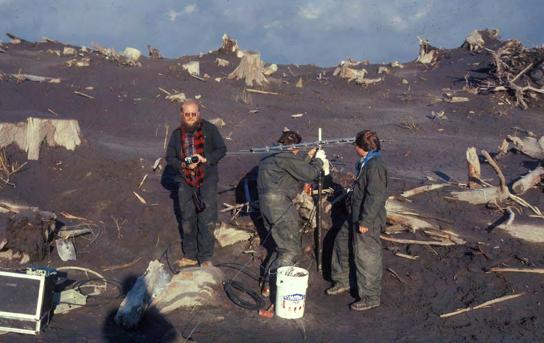
This year marked 43 years since the eruption of Mount St. Helens on May 18th, 1980 at 8:32 AM. This is an important day in Washington State history, and for the ESS Community.
We remember ESS Graduate Dave Johnston, a USGS volcanologist stationed at Mount St. Helens to monitor the unrest in 1980. He was one of 57 people who tragically lost their lives in the lateral blast.
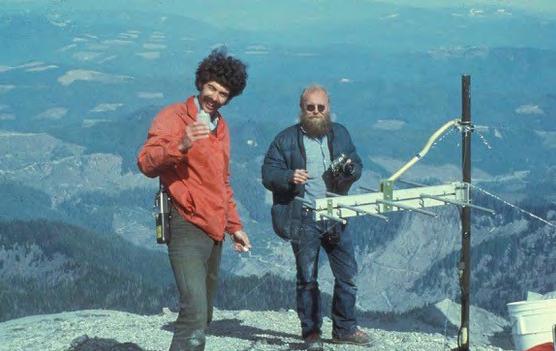
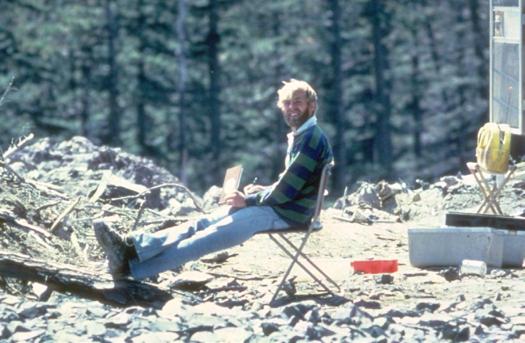
Each year during our Annual Department Awards Ceremony, ESS gives out two awards
funded by the David A. Johnston Memorial Fellowship for Research Excellence. This award is presented to two graduate students considered to be the most outstanding young scientists in the fields of Geological Sciences and Geophysics. This year’s award recipients were PhD Candidates Annika Horlings and Nicholas Wogan.
ESS and Pacific Northwest Seismic Network (PNSN) Steve Malone was the key seismologist who recognized the developing swarms of earthquakes and alerted the USGS and authorities of the potential for an eruption, setting in motion a huge effort from March to May, 1980. And now 43 years later, Steve continues to be a very active and invaluable member of PNSN’s team, even though he officially “retired” in 2007.
Today, PNSN in partnership with USGS and other institutions and universities work together to operate the national volcano early warning system that evaluates and monitors all the volcanoes in the US. This is a critical service that PNSN and ESS scientists perform for Washingtonians and everyone living in areas near volcanoes, and a responsibility they take very seriously.
A Hero on Mount St. Helens, The Life & Legacy of David A. Johnston by Melanie Holmes is a moving chronicle of Dave’s life and the events that led him to be on Mount St. Helens in Spring 1980.
The Department greatly appreciates that Lee Fairchild, who helped create the Johnston Fellowship, stays in close touch and continues to support our community.
For many ESS students, the summer field geology course is a mind-expanding opportunity to confront the complexity of geologic systems face-to-face. It is an opportunity to integrate concepts and techniques from core courses and apply them to “full strength” geologic problems. Covid-19 and restructuring of the UW summer budget both disrupted ESS’s long tradition of field training in Montana, driving us to consider a Seattlebased field course. The course combines skill-development in field observations and mapping with geophysics, engineering geology, geographic information systems (GIS) and report-writing.
The newly-designed course, Pacific Northwest Field Geology with GIS, follows the traditional intensive six week format, minus the logistics of transplanting students and faculty to Montana. The course draws from the spectacular geology of western Washington: measuring section in the glacial stratigraphy; landslide mapping in the field and using lidar-derived topographic maps; bedrock mapping in the Lopez Structural Complex; geologic mapping in the Naches Formation near Snoqualmie Pass; a structural interpretation of the Chuckanut Mountains south of Bellingham, including a down-plunge projection of the folds; and a gravity survey and cross section from geotechnical boring logs across the Seattle Fault Zone.
Working locally has additional benefits. Because we have access to department computer labs throughout the course, students can build projects with GIS fully integrated, so
each project interleaves field and lab work. Because we can draw on our local contacts, we are able to engage professional geologists outside UW to meet with students in the field and highlight the career-relevance of the coursework. Students build expertise in the local geology and geologic data sources, further advancing their preparation for geology jobs in our region. And the locally-hosted camp means that students with family or other obligations that prevent them from traveling can fully participate in this important capstone experience. This benefit extends to faculty and to graduate teaching assistants: we expect to have a growing roster of faculty instructors who participate in the summer course, because they will no longer have to leave their
families (or their laboratories) behind.
The ESS Summer Field Course remains an important and transformative capstone experience for students. The new format enables ESS to make a continued commitment to field training, while enhancing access for students.
Many people were involved in creating this new course, including Professors Juliet Crider, Steven Walters, Cailey Condit, Darrel Cowan, and Alison Duvall, and graduate students Elizabeth Davis, Erich Herzig, Max Needle and Paul Morgan. ESS graduate students Tristan Bench, Jonathan Gates, and Emma Heitmann helped ensure that the first offerings of the course ran smoothly.
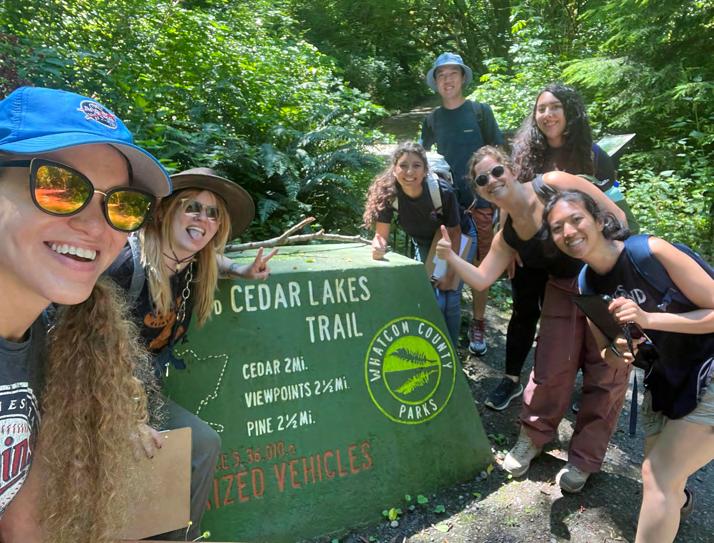
1st Place
Jonathan Gates
Volcán de Fuego, also known as Chi Q’aq. Active stratovolcano near Antigua, Guetemala. Photo taken from the flanks of Acatenango (another stratovolcano in Guetemala) in March 2023.

2nd Place
John-Morgan Manos
Dendrite snowflake landing on a wool glove. Photo taken in Allan Hills, Antarctica.

3rd Place
Ze-Zhou Wang
Drumheller Channel
Basalt Columns in Columbia National Wildlife Refuge, eastern WA.

ESS 463 Structure & Tectonics, taught by Prof. Darrel Cowan, is celebrating its 20 year anniversary!
As part of an obligatory field trip, students spend four days in the field at the Shoshone Education and Research Center (SHEAR) in Death Valley, California.

The region centered on Death Valley is a geological wonderland that preserves a record of Earth history for the last 1.7 billion years. Students, as part of an actual research project, acquire structural data in the field and analyze them to address their compatibility with a hypothesis
concerning low-angle normal faults.
When asked “what is your best memory or experience with the ESS program”, many ESS students answer with this class field trip.
Although Cowan has retired, we expect to be able to continue to offer ESS 463; we have several faculty both qualified to teach it and interested in doing so.
“My favorite parts of the Death Valley trip were the combination of the community aspect of the trip (you really get to know your classmates on a different level, which in turn helps with the collaboration and trust) and
the real-world aspect of the trip. Being able to go out and actually touch and measure what you learn and see in the classroom is a huge asset and extremely beneficial for learning the material. Having the option of a class like this really helps make the geology tangible and meaningful.
My advice [for students] would be to take this course and utilize it as much as you can. Make connections with your classmates and collaborate. My learning in this class came from my own experience rather than a conveyed or theoretical explanation of how the processes of the earth work.”
Graham Johnson, ESS Geology
Post-baccalaureate student, graduated in Spring 2023


Building eSteam (Education in Science, Technology, Engineering, Astrobiology, and Math) is a student-led initiative providing tutoring/mentoring to incarcerated youth within the Seattle area.
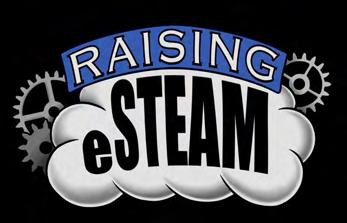
ESS graduate students Autum Downey, Pete Wynn, and Lucas Fifer have been very active in this ongoing effort. Building off NASA’s Astrobiology for the Incarcerated program, eSTEAM provides weekly tutoring at the Echo Glen Children’s Rehabilitation Center in Snoqualmie, WA. The goal is to connect with students one-onone and provide the support needed to keep them on track with their education. Through individualized tutoring, eSTEAM fills in gaps within their primary classes and facilitates career planning/mentorship. The weekly visits to the center from eSTEAM volunteers are the students’ connection to the outside world.
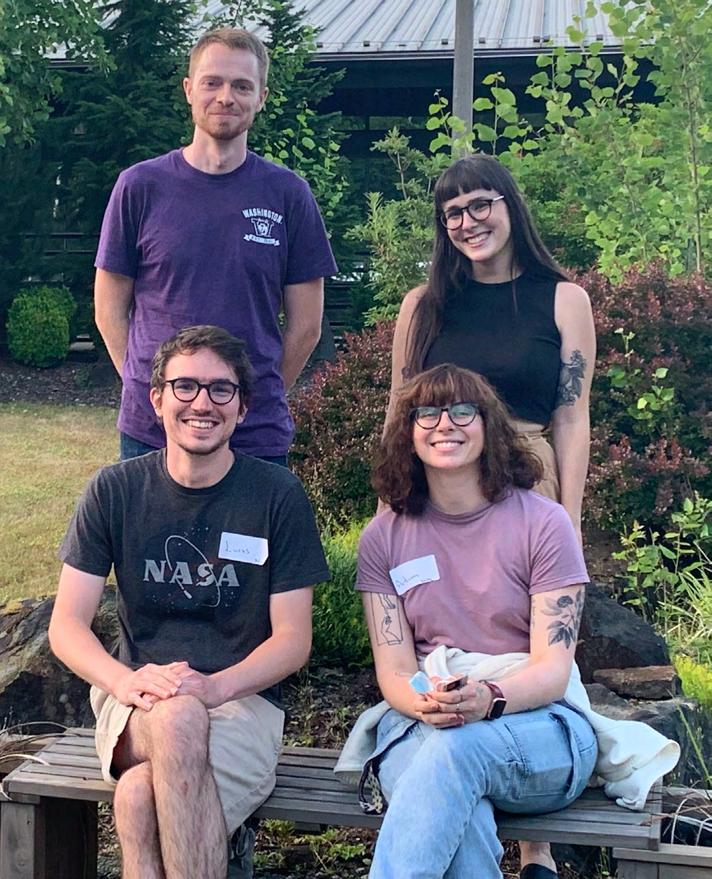
Autum, Lucas, and Pete have been going weekly for over a year and note that the students’ attitude and willingness to learn and ask questions has changed dramatically over the course of a year. The students at Echo Glen, more than anything, just need someone they trust to support and believe in them. eSTEAM has also been leading after school science activities.
Most recently, eSTEAM set up a “crystal garden” where the students grow crystals in a test
tube while discussing the science behind it. Hopefully many more activities are to come.
If you would like to read more about the eSTEAM program, check out the article in popular science. https://www.popsci. com/science/astronomy-prison-education-programs/
I am a bit of an unconventional student in that I worked for many years in a variety of fields before being afforded the chance to pursue my degree in Geoscience.
I have always had a passion for the outdoors and the natural world. I was raised in a very poor, rural mountain community in the southeast where most women don’t get very far in their education, and typically end up spending their lives without ever going to college. No emphasis was ever given on pursuing a degree for me, and I never thought becoming a scientist was an option. When I graduated high school I decided to work abroad doing farm work on organic farms and homesteads. This path allowed me to learn a lot about soil science, botany, general basic gardening chemistry, and sustainable land practices. After a couple of years doing this I became a small business owner and worked for a long time running a couple of different businesses.
In 2020, my family and I had just moved to Washington from North Carolina and were trying to get settled into establishing our small business here in the PNW. The pandemic was a very challenging time, and forced us to shut doors on my business. I am a mother of 3 kids whose ages range from 10 to 18 years old. Suddenly, I was faced with all of my kids being homeschooled, me out of work, and my husband trying to find a way to keep working during the shutdown. I

reflected a lot during these first few weeks of shutdown on what I wanted my life to look like from that point on. I had a successful small cleaning company that I loved, but was suffering back issues as a result of that kind of work and was ready for a big change. I decided it was time to finish getting a degree. I had started working on an AA degree in N.C. years ago, but kids and money and business opportunities kept me from fully finishing that.
After some deep reflection I realized that I have always been a scientist in my mind and that I could actually pursue those interests with a career in Geoscience. I consulted with friends and family and applied to go back to school. I went to Olympic College for the first year and applied to UW, and was accepted in 2021. It was the best decision I have ever made, and I have been rewarded so much along this educational path. It has not been easy to say the least, but it has been the most fun and interesting experience.
During my studies at UW, I have discovered I am very interested in the micro scale of geoscience, and have navigated into geochemistry and petrology as a focus. I hope to be able to maintain a research and applied science approach with my degree. I also hope to be able to work on environmental remediation applications and sustainability issues. I want to return to UW for graduate school eventually, and plan on applying this fall for the 24/25 school year if possible.
I never thought that I had options available to me such as becoming a scientist because of my financial and educational
background. One day I was having a casual discussion with another woman I had just met, and she described to me how she had decided as an adult woman and a mom to become a neuroscientist. I did not realize you could decide something like that until I saw that she had, and after some time thinking about it I knew that was a decision I could make.
Raising 3 kids and going to college for a fairly challenging degree has pushed me to the edges of what I thought was possible and I have grown immensely. My kids have been able to watch me achieve this degree and have been inspired by the fact that their mom decided to become a scientist and actually made it happen. That really is the greatest reward of it all, to show them that if you have a dream it is worth it to pursue that to the best of your ability.
Sharing stories like mine may be the difference between someone actually realizing they are able to make a choice such as become a scientist, or anything else you want to be, and I hope my story can do the same for someone else as my friend’s story did for me, because it completely changed my life based on one simple conversation. I want to be able to inspire others to use science for the betterment of humanity. I love this field, and am excited to see what it holds for me.

 Dr. Fang-Zhen Teng (left) postdoc Ze-Zhou Wang, visiting scholar Zuxing Chen, and PhD student Winnie Fan in the Non-Traditional Isotope Laboratory.
PhD student Winnie Fan, postdoc Ze-Zhou Wang, and PhD student Tianyi Huang.
Dr. Fang-Zhen Teng (left) postdoc Ze-Zhou Wang, visiting scholar Zuxing Chen, and PhD student Winnie Fan in the Non-Traditional Isotope Laboratory.
PhD student Winnie Fan, postdoc Ze-Zhou Wang, and PhD student Tianyi Huang.

Earth’s continental crust has diverse ages and lithologies, with an average andesitic composition, differing from the basaltic crust dominating Earth’s seafloor and outer layers of other terrestrial planets. It holds rich clues to Earth’s geologic history. My Ph.D. research focuses on potassium (K) and its isotopes in the continental crust. As an incompatible and lithophile element, K is concentrated into the crust during crustmantle differentiation. Due to its solubility, K is preferentially leached into aqueous solutions during continental weathering rather than retained in the weathered crust. These geochemical features lead to large differences in K concentration in the hydrosphere, crust, and mantle. Potassium has two stable isotopes, 39K and 41K, with >5% mass difference, which can lead to large K isotope fractionations via geological processes. Potassium isotope geochemistry thus offers great potential for studying the continent formation and evolution.
I began my Ph.D. studies in ESS at UW in fall 2017 when our Non-Traditional Isotope Laboratory pioneered highprecision K isotope analysis using MC-ICPMS. Through extensive experimentation, we achieved the highest analytical precision and successfully resolved K isotopic variations in natural samples. Following my initial
efforts to help establish the analytical protocol for K isotope analysis, I decided to use K isotope geochemistry to study the formation of the continental crust for my Ph.D. dissertation.
My first project looked at the K isotopic composition of the upper continental crust, and I analyzed various upper crustal samples. I found heterogeneous K isotopic compositions in sedimentary rocks and granites. Variations in sedimentary rocks reflect continental weathering, whereas variations in granites may reflect either source heterogeneity or magmatic differentiation.
The unsettled origin of K isotopic variations in granites drove my second project. To constrain K isotope behaviors during granitic magmatism, I analyzed two sets of co-genetic granitoids and their K-bearing minerals. I found large K isotope fractionations among the granitic minerals, with plagioclase being highly enriched in heavy isotopes compared to other minerals (e.g., K-feldspar, mica, and hornblende). My study led to the prediction that plagioclase cumulates have heavy K isotopic compositions, while the differentiated melts are isotopically light. This prediction was confirmed by our recent study led by Dr. Ze-Zhou Wang, a postdoc researcher in our lab, which revealed that plagioclaserich two-mica leucogranites from the Himalayas are indeed isotopically heavier than muscovite leucogranites representing highly differentiated melts.
Based on my findings of K isotopes as useful tracers for chemical weathering and crustal differentiation, I laid out my third project to investigate the
temporal K isotopic variation of the continental crust. I analyzed K isotopes in glacial diamictites from Archean to the present, representing average crustal compositions through time. I found large K isotopic variations in the Archean samples but more homogeneous compositions in younger samples. I interpreted this change as reflecting a transition from Na-rich to K-rich continental crust and decreasing weathering intensity over time.
Throughout my Ph.D., I advanced the understanding of K isotope systematics, particularly in the continental crust, and demonstrated the importance of K isotopes in tracing continental evolution. After defending my dissertation at the end of May 2023, I began a postdoctoral research position at Lawrence Berkeley National Laboratory to expand my expertise in isotope geochemistry, investigating clay minerals’ formation, transformation, and applications in environmental sciences.
same thing for those interested in the chemistry side (e.g. ice core and paleoclimate have a lot more chemistry) about having a strong chemistry background.”
The COVID-19 pandemic was incredibly disruptive for graduate students and their research, including Hills. His first field season at Hercules Dome was over the ‘19-’20 winter, ending in February 2020. He was not able to return until this past winter season, three years later. Unfortunately, due to a COVID outbreak at McMurdo station, their trip was delayed and they were forced to make daily flight commutes from the South Pole, rather than camping at their field site.
temporal and spatial scales a lot more having been in the field. However, being 100% invested in a field project can be a risk, especially as a student. Fieldwork has a high probability of failure; that is simply the nature of doing scientific research in a remote place. Having contingency plans for what science you can do if the fieldwork fails is important.”
Antarctica is one of the most remote places on earth to conduct field work. Ben Hills, who completed his PHD last spring under the supervision of Knut Christianson, conducted field work at Hercules Dome in Antarctica over this last winter season, from November to February, along with ESS research faculty member T.J. Fudge and new graduate student Liam Kirkpatrick. (See also page 26).
Hills became interested in glaciology during his undergraduate degree at Montana State. “I was bridging between science and engineering by studying snow. That turned me on to polar science and its critical role in global climate.”

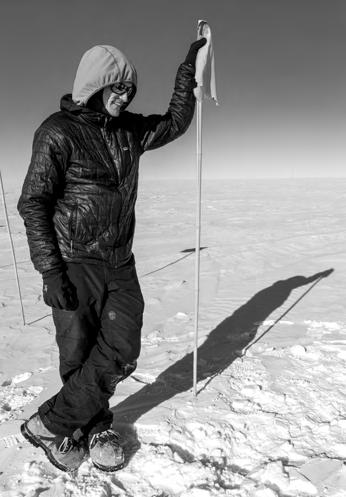
For students interested in the field of glaciology, Hills advises “develop a strong quantitative background before pursuing a niche field like glaciology. A strong understanding of calculus, differential equations, statistics, conservation laws, etc., is all important for any physical science discipline. I would say the
A typical deployment to Antarctica, where they are camping at the field site, “a day starts and ends with cooking and conversation. Those times can be critical for discussing strategy or debriefing,” Hills explains. However, “staying away from the field site means our science is significantly less effective. Not only do we have a 1.5 to 2 hour flight at either end of the day, but there are some instruments that cannot be left in the field alone.” This meant that every day they had to set up their instruments in the same location they were at the previous day, and then take them down again at the end of the day.
While their survey was not designed to be done in these day trips, and this made it more difficult overall to accomplish their objectives, they were able to obtain enough measurements to finish the project.
Hills also has advice regarding fieldwork in remote places. “Don’t make fieldwork your only priority. Getting some exposure to fieldwork can be huge in shaping how you think about Earth systems. You will appreciate the
So, what does Ben love about fieldwork? “I like being on a small team with a shared mission directive,” he says. “In the field, it needs to be very clear what the scientific objectives are. We spend significant time leading up to the season having discussions about the science, what the objectives are and possible contingencies. There is a team dynamic that develops through that process which brings people close together, both as scientists and as friends.
Having a small team on a mission: that is what is great about fieldwork.”
(Top right) PhD students Benjamin Hills and Liam Kirkpatrick commuting via snowmobile to the planned survey location. (Lower right) The team getting ready to depart. (Left) Benjamin Hills. Photo credit for all: Kelsey Kushneryk


Every year, GeoClub takes a trip during Spring Break. This year, GeoClub took a trip to Northern Arizona. Our plan was to start in Las Vegas, drive to the Grand Canyon, spend a few days in Flagstaff, and then drive South through Sedona and Prescott to Phoenix.
In addition to being a fun road trip, this trip was structured as a 1 credit class in which each of us picked a location to learn about. Once we were there, we presented on our topics of “expertise”. Below is the story of our trip told by each day’s expert along with commentary about the personal impacts and value of this kind of experience.
Ultimately, our trip was not only a really fun thing for us to do, but it was a genuine learning experience that extended beyond geology and taught us about leadership, organization, and resilience.
The Hoover Dam is both an important geological and anthropological site. It was constructed during the great depression to provide water and power to the growing southwest population and to create jobs. The dam impounds lake mead, which provides water to California, Arizona and Nevada, but was at a record low at the time of the trip (which is bad). The most obvious geology we were able to see were the
volcanic tufts which lie at the base of the dam. It was really interesting to see a landmark I had heard so much about growing up in California, but had not been able to visit until then. There was also a very large memorial to all of the men who died building the dam which I found quite interesting.
Unfortunately, we did not end up going to Hualapai Mountain Park but I enjoyed the GeoClub nonetheless! Field trips and going outside was a huge reason why I joined ESS and it was very fun to go on a field trip surrounded by other students who were enthusiastic about rocks and learn about the geology we could see in front of us. The fact that so many costs were covered by the GeoClub made it a lot easier for me to sign up and learn about geology in the field.
Just about 5 minutes away from the visitor center, Mather Point is the first glimpse of the majestic canyon for many visitors. From there we could observe all the rock formations that we wanted to see, such as Kaibab Limestone, Coconino Sandstone, and Vishnu Schist, before visiting the Yavapai Geology Museum and then the Trail of Time.
The ‘Trail of Time’ was indeed a very interesting and interactive part of our GeoClub trip where
it was a wholesome experience with regards to the geologic history of the Grand Canyon. This 2.8 mile trail displays lithologies according to the stratigraphy of the canyon where we were able to observe rock properties and derive understandings on the petrology and structure. We also discussed the Native American history at the national park and how as geologists our work intertwines with Native reconciliation and most importantly respect to the land.
When we woke up the next morning, a lot of snow had fallen on our campsite. Our tents were sagging, and the morning was freezing. Our initial plan for that day was to go hiking down into the canyon, but given all the fresh precipitation, we deemed that ill advised.
Instead, we got in the car, leaving our camp and the Grand Canyon behind and drove through the beautiful Kaibab and Coconino National Forests toward Petrified Forest National Park. In the park, we got to see the painted desert (Chinle formation) and the huge petrified logs from the late Triassic. These were deposited on the southwestern corner of Pangea in a humid, sub-tropical environment.
When we got back all our tents were under a substantial amount of really wet snow. Unfortunately, a couple of the tents were pretty... (continued on page 23)








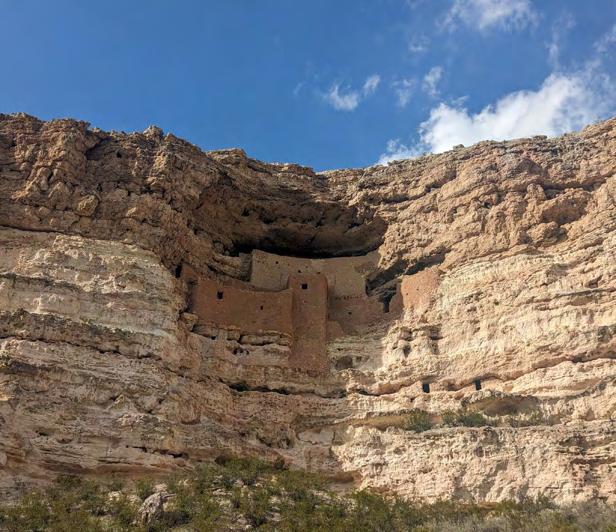
...badly damaged, and had a few inches of water at the bottom. In the interest of not freezing everyone to death overnight, we packed up camp and made our way to Flagstaff. On the way back, one of the vehicles hit a pothole just right and popped our tire. Despite the difficulty of packing up camp, the cold and uncomfortable conditions, and dealing with car issues, everyone was so calm and so positive, and made the best out of a tough situation.
Formed 50,000 years ago during the Pleistocene, this crater exposes stratigraphy from the Coconino Sandstone, Toroweap Formation, Kaibab Formation, and Moenkopi Formation. Telescopes placed along the viewing platform allowed us to see items within the crater, such as a life size astronaut statue. It was incredible to see just how small the statue was to the bare eye. The crater is much larger than it seems at first glance! We also took the time to walk through the attached museum. This trip was a great chance to see amazing geological formations far different from what I see locally and that I would not have been able to see otherwise!
North of Flagstaff lies the San Francisco Volcanic Field. The night before Day 5, we were able to take a quick look at some of what San Francisco Volcanic Field had to offer. We saw the prominent SP Crater cinder cone and the dramatic Black Point Lava Flow. In the morning, we
set out to explore the area’s youngest volcano, Sunset Crater, which is an active cinder cone having last erupted about 950 years ago. Sunset Crater is also distinguished as a geological site with major cultural significance to the Dine and Hopi peoples. We walked on the Bonito Lava Flow, west of Sunset Crater, where we saw an ‘a‘ā lava flow up close. We then saw the San Francisco Peaks Stratovolcanic Complex which is a remnant of the former San Francisco Mountain which stood at about 15,000 ft. The San Francisco Volcanic field is not only a place of major geological interest, but it is also extremely culturally relevant to the region. Seeing the Wupatki Pueblo, we further learned about human and geological interaction and the cultural significance of the land we are exploring.
After spending some time in Flagstaff we made our way down to Sedona where we spent time exploring the city, and driving down the famous Scenic Byway (SR 179). Here we got to see some classic rock formations and viewpoints. We all gathered at Bell Rock to dig into some geologic fun facts, learning about the Schnebly Formation, and how iron oxides turn the sandstone red! Interestingly, this sandstone was deposited all the way back in time during the Permian period about 275 million years ago. As an undergrad studying environmental science and paleobiology, going on this geology trip was very educational for me! Throughout my education I haven’t been able to learn as much about geology as I would like, so having the ability to go on a fully funded trip
designed around geology was a special experience for me!
We had a leisurely start to our last day, but after packing up our campsite and going into town for some breakfast, we headed to the Granite Dells. Beautiful proterozoic granite that formed 5 km down that got uplifted to the surface where then the process of spheroidal weathering formed the bulbous texture we see today.
This stop was a nice quiet view of an amazing dwelling 150 feet up the side of a limestone cliff. The Castle is the abandoned dwelling of the Sinagua people built 900 years ago and is the third National Monument on our trip. It exemplifies the crossover of indigenous culture and the geology of Arizona that is important to note and understand. Most of the stops we made were heritage sites or near sacred land for one or many indigenous peoples. To have the opportunity to experience these sites and learn about the science of how these amazing aspects of geology came to be was extremely valuable to me.
Photo description and credit from left to right, top to bottom: Meteor Crater, Akshay Mehra; repairing flat tire, Nicole Aikin; Daniel Cruz teaching at Wupatki National Monument, Nicole Aikin; Students at San Francisco Volcanic Field, Akshay Mehra; Nicole Aikin and Daniel Cruz petrology lesson at Watson Lake Park, Linh Vu; Montezuma Castle, Linh Vu.
This trip was a great chance to share my geology knowledge as a graduate student and geologist working in the field. I enjoyed showing students how to use a brunton compass to measure the strike and dip of beds. Answering career related questions was also a chance for me to reflect on my own career path.
By Nicole Aikin (PhD)As a National Science Graduate Research Fellow, this trip provided me with my first teaching experiences in the area where I conduct my Ph.D. research (Grand Canyon and Colorado Plateau), which was absolutely invaluable. It challenged me to distill complex

geologic concepts into digestible lessons and confirmed my passion for teaching and desire to pursue an academic career. Hands-on field experiences are essential for contextualizing Earth Science concepts, building lasting relationships, and mentoring students. The exceptional undergraduates on this trip inspired me, and the ongoing mentorship that has followed would not have been possible without this experience.
I hope that we’ve demonstrated that this was a worthwhile experience for all of us. We saw and learned so much in the span of a single week.
One unique aspect of this trip is that we got to plan it. The places we went were entirely decided
by us, so we got an opportunity to learn to plan, direct, and lead, which is super valuable. These sorts of programs where we get to be in the driver’s seat teach us things like strength and leadership that cannot be simulated in a classroom setting.
I also want to drive home that this trip would have been impossible without support from the department. Being a student is expensive. Under normal circumstances, I can’t get 13 of my friends to drop everything to go to Arizona for a week. I think it’s important to have programs that allow people to go out and experience the world, to experience geology first-hand regardless of socio-economic status. Aside from standard tuition and the many, many souvenirs, this trip didn’t cost students any additional money.

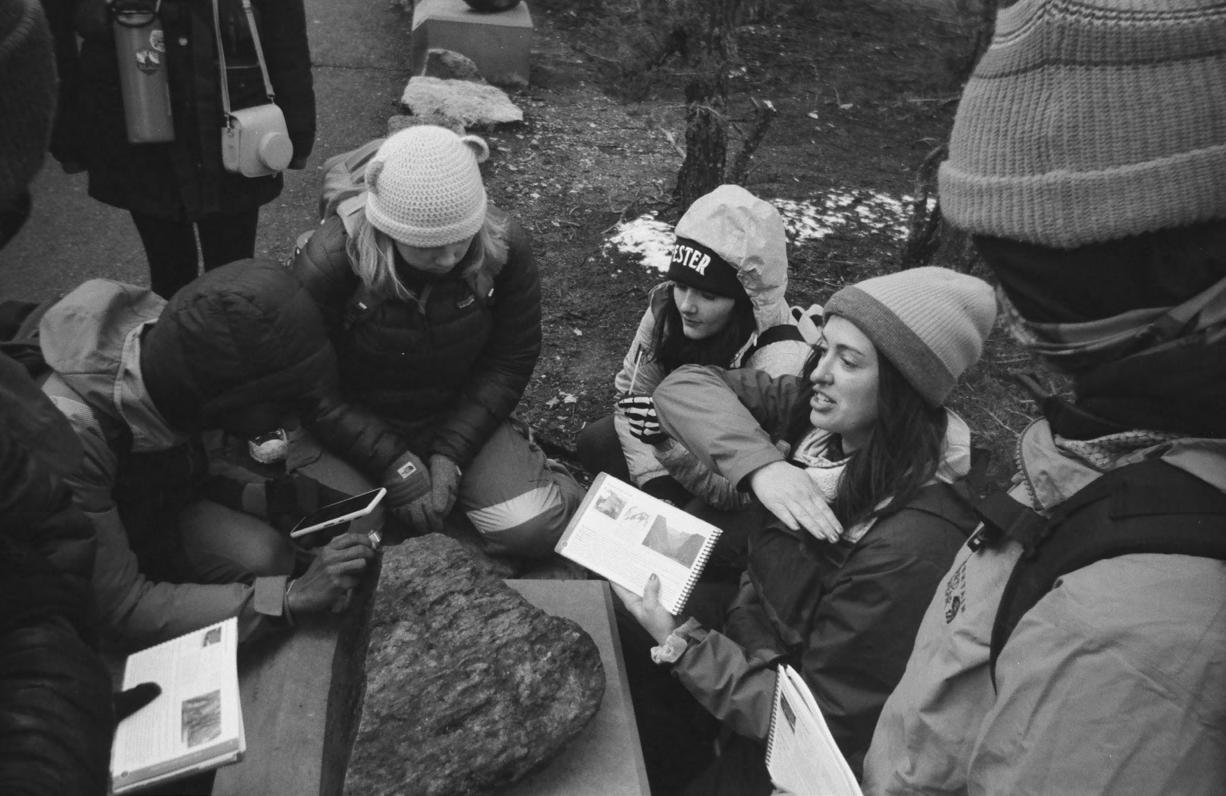

Ice cores from the polar regions provide the most direct information possible about the climate in the past, an important part of understanding how climate will change in the future. The University of Washington glaciology group has played a leading role in ice core research for decades, and that legacy continues with two major decade-length projects funded by the National Science Foundation.
The Hercules Dome project, led by ESS Professors Eric Steig, TJ Fudge, and Knut Christianson, aims to obtain ice from the last interglacial period, about 130,000 years ago, when the West Antarctic ice sheet (WAIS) may have collapsed. Knowing whether, and how quickly, the WAIS collapsed is critical for understanding the risk of similar collapse in the future. A complete loss of the WAIS would raise sea level by about 3 meters.
Hercules Dome is uniquely sensitive to the size of the WAIS, because it lies in the mountains immediately adjacent to it. Fieldwork over the last few years has selected the best location to drill an ice core (see page 18).
The COLDEX (Center for Oldest Ice Exploration) project is an NSF “Science and Technology Center”, led by faculty at Oregon State University, with UW as a major partner. Professor Michelle Koutnik is the lead at UW, and the project also involves Steig, Christianson, Fudge, Prof. Dale Winebrenner, and others. The COLDEX Science and Technology center brings together an ambitious research program with coordinated education, outreach and knowledge transfer programs. The aim of the COLDEX project is to find and analyze the oldest ice on Earth; the project has already discovered and begun to analyze
ice more than 4 millions years old. The goal now is to obtain, if possible, a continuous record extending through that entire time period, or longer.
The Hercules Dome and COLDEX projects represent the largest current NSF investments in ice core research, and will also involve students and faculty from dozens of other institutions. Together, these projects provide an opportunity to make progress on a number of science priorities, including understanding the environmental conditions of the last interglacial period, the history of gases and aerosols in the atmosphere, and the magnitude and timing of changes in temperature and snow accumulation over the ice sheets, over millions of years.
Learn more at:
herculesdome.org and coldex.org
Obtaining ice cores necessarily means having somewhere to keep them frozen. Although most of the ice from the Hercules Dome and COLDEX projects will be archived at the National Science Foundation’s national Ice Core Facility, it is critical for students and faculty to be able to work on ice samples at their own labs. A critical piece of research infrastructure is currently lacking at UW: a reliable cold lab.

In addition to ESS faculty, UW has numerous faculty who are internationally recognized for their expertise in conducting research in extreme cold environments. ESS has been working together


(Professors Joel Thornton and Becky Alexander) to build a new lab, which will be used both for preserving and examining highly-valuable ice cores and for simulating upper-atmospheric conditions and high latitude conditions. The lab will be located where the old Quaternary Research Center freezers were; the old freezers were built in the 1960s,
and are no longer functioning, and were removed earlier this year. The new cold lab will provide opportunities for crossdisciplinary collaboration and help to maintain UW’s position as a global leader in glaciology and climate science.
The Department is working to secure a combination of institutional and private funding for this vitally important project. Please contact Eric Steig (steig@ uw.edu) and Eryn Boyles Ilk (boyles@uw.edu) to learn more.
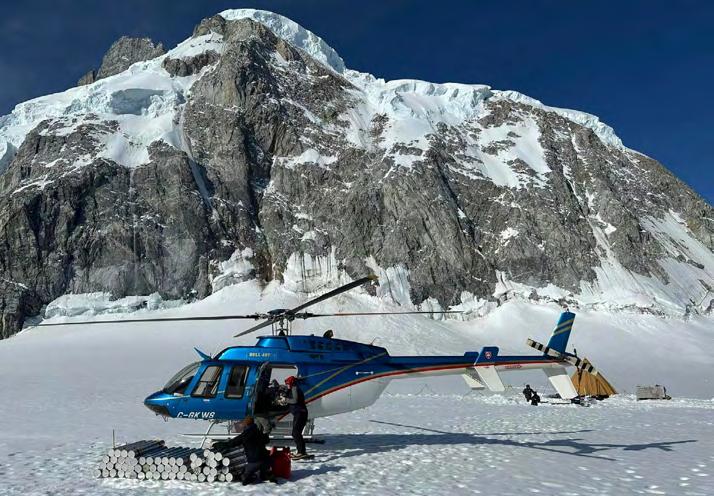
Ethnic and racial diversity of those with doctorates in geoscience is the lowest among all STEM fields in the United States, and has seen no improvement over the past 40 years. Since there are no national standards for geoscience education at the primary or secondary school level, many students are not exposed to these topics in the classroom before entering university. Additionally, K-12 schools that do offer geoscience classes do so in addition to required curriculum, and thus tend to have more resources and serve more privileged communities, which further serves to exacerbate geosciences’ diversity problem. A key aspect of increasing diversity in geosciences is therefore contingent on exposing K-12 students to relevant geoscience curriculum.
Here in the Earth & Space
Sciences Department, we are working to teach K-12 students geoscience through the Rockin’ Out Outreach Program. In the past two years, Rockin’ Out has reached approximately 1500 K-12 students through lab tours at UW, guided field trips, tables at school STEM nights, and visits to local classrooms.

Rockin’ Out is currently run by ESS graduate students, Madeleine Lucas and Anna Ledeczi, who serve as the program coordinators. In this role, they plan all Rockin’ Out events by developing lesson plans, communicating with educators and schools, and training and supporting volunteers. They also volunteer at events each quarter; for example, they attended an AGU education section event at the Adler Planetarium this December where they taught families how to identify rocks and minerals,
as well as promoting the UW ESS undergraduate program. In order to target underserved communities more effectively, Rockin’ Out has pursued a partnership with the Northwest Earth & Space Sciences Pathways (NESSP) Program, a NASA-funded outreach program, and the UW Riverways Program. Using the NESSP framework, Rockin’ Out have been able to engage in short outreach events at rural and tribal schools in Washington as well as underserved communities in the Seattle area. NESSP actually began in ESS under Robert Winglee’s leadership and is now led by one of Robert’s former students at Central Washington University.
In February 2023, ESS student volunteers Tamara Aranguiz, Barrett Johnson, and Heather Maran developed a geomorphology activity for high school students at the Seattle
World School, which serves newcomer secondary students who are linguistically diverse, including those from refugee or immigrant backgrounds. The students built geomorphic features from modeling clay— an interactive lesson designed specifically for students with limited knowledge of English— and were able to interact with

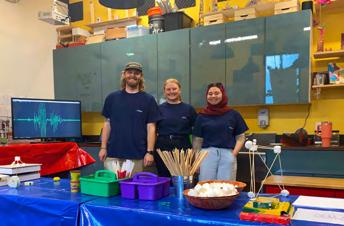



ESS volunteers who speak Russian and Spanish. The students were overjoyed at learning in their native languages, and sent a heart-felt thank you note to volunteers after the lesson. Students from other schools partnering with NESSP have visited labs in ESS, such as the Geomicrobiology Lab and the PNSN SeismoLab.
Unfortunately, Rockin’ Out has to turn away the majority of requests for events from the community. We aim to improve this by practicing more effective community engagement by prioritizing lasting partnerships with particular schools through repeated volunteer events. Doing this will require expansion of our program: the department hopes to involve more faculty and students, to further support the department’s efforts to broaden participation in the geosciences. We all stand to benefit from a greater commitment to community engagement and science education.
If you are interested in volunteering with Rockin’ Out, please email:
rocknout@uw.edu.
If you would like more information about getting involved and ways to support programs like this, please visit the community section of our web page:
ess.uw.edu/alumnicommunity/ess-community/


As the backbone that connects the internet between continents, countries, cities, and buildings, optical fiber cables are ubiquitous. New technology has enabled the use of this infrastructure for environmental sensing.
The basic measurement principle is that photons that pass through optical fibers are modified by the environment of the cable. Using this principle enables scientists to measure the cable temperature, strain (how stretched out it is), and even use the cable as a microphone or seismometer (for example, to record earthquakes). These measurements are distributed because they can be made with high spatial resolution as fine as 25 cm at baselines up to 150 km. These technologies go by the names Distributed Temperature Sensing (DTS), Distributed Acoustic Sensing (DAS), and Distributed Strain Sensing (DSS).
Professor Brad Lipovsky’s research group in the Department of Earth and Space Sciences has been hard at work taking this technology around the world. ESS graduate student John-Morgan Manos made measurements of ocean swell impacting an ice shelf at McMurdo Station, Antarctica in December. ESS graduate student
Verónica Gaete-Elgueta has been tracking earthquakes in the Puget Lowlands using a subsea fiber in the Saratoga Passage (between Whidbey and Camano Islands). ESS graduate student Yiyu Ni (in Marine Denolle’s group) has been using DAS measurements in the city of Seattle to investigate the geotechnical structure of the subsurface. Applied Math
graduate student Laurel Doyle has been using machine learning to discover the governing equations of nonlinear ocean surface waves using data from a subsea cable on the Oregon Coast. ESS graduate student Parker Sprinkle (also at Pacific Northwest National Labs) is analyzing DAS data from a geothermal reservoir that gives new insights into engineering these systems.
Some of the most exciting work is yet to come. This summer,
postdoc Dominik Gräff will deploy an optical fiber cable in a fjord in Greenland in order to understand the calving of large icebergs there. Postdoc Ethan Williams and others from across the UW will work with data from a submarine cable in Alaska that will likely contain many earthquake and marine mammal recordings. A proposed project at Mt. Rainier will support several ESS graduate students and investigate the use of optical fiber sensing as early
warning systems for catastrophic landslides.
This work has been made possible by an award from the Murdock Charitable Trust and startup funds from the Department of Earth and Space Sciences and the UW.
fiberlab.uw.edu
Graduate student John-Morgan Manos on the McMurdo Ice Shelf. The projects in Antarctica included two experiments using fiber optics: 1) a 5 km single mode cable and distributed acoustic sensing (DAS) interrogator were deployed on the McMurdo Ice Shelf and 2) a multimode cable and distributed temperature sensing (DTS) cable were deployed into a previously drilled borehole in the Allan Hills blue ice zone. on McMurdo Ice Shelf, researchers are interested in learning more about the cryoseismic activity of the ice shelf as tidal forces were driving motion. At Allan Hills, they were interested in collecting a high spatial and temporal resolution temperature profile of the ice in this region. Photo credit: John-Morgan Manos


The Discoveries in Geosciences (DIG) Field School is a unique, non-profit education and outreach program for K-12 teachers created by Burke Museum paleontologists.

Founded in 2009 by University of Washington (UW) Professor of Biology, ESS Adjunct Professor, and Burke Museum Curator of Vertebrate Paleontology Dr. Gregory Wilson Mantilla, the DIG connects K-12 STEM teachers with scientific research and researchers through ongoing professional development and teaching curricula, and provides teachers with an immersive learning experience through a four-day professional development program at active field research sites in Montana and Arizona, as well as yearround educational resources, support, and engagement with authentic research at UW and Virginia Tech.
The field component of the DIG takes place each summer and provides K-12 teachers with a four-day introduction to paleontological and geological fieldwork and research. Participants in the program work side-by-side with leading researchers in the geosciences from institutions across the country and receive handson training in field collecting and research techniques— including collecting dinosaurs and other fossils. They also engage in activities and discussions surrounding STEM education, pedagogy, and the Next Generation Science Standards. This immersive professional development opportunity provides educators with authentic fieldwork and research experience as well as added depth and breadth to their background in science. We invite teachers of all age groups and backgrounds to apply to the program, and we encourage
anyone from communities representing Black, Indigenous, and people of color to apply. Teachers that participate in the DIG receive continuing education credits upon completion of the program.
Over the last 12 years the DIG has taken place in the Hell Creek region of northeastern Montana. This region is famous for its preservation of charismatic dinosaur fossils like Triceratops and Tyrannosaurus rex as well as fossils deposited before and after the Cretaceous/Paleogene (K/Pg) mass extinction event. As such, the Hell Creek region has remained an epicenter for paleontologists, geologists, and other scientists from around the world and is also an excellent outdoor classroom. Each year, we accept approximately 30 teachers to join our field team in Montana. The DIG team is comprised of DIG Director Greg Wilson Mantilla, DIG Program
Coordinator Rachael Canaday, UW ESS graduate student Brody Hovatter, Burke Museum
Assistant Director of School and Teacher Programs
Katharine Canning, and Burke Box Manager
Devin Leatherman, as well as numerous professors, postdoctoral researchers, graduate students, undergraduate students, and volunteers from the UW and elsewhere.
New to the program this year is the DIG Field School Petrified Forest (DIG PEFO), which will take place at the Grand Canyon and Petrified Forest National Parks in Arizona. DIG PEFO participants will engage in similar activities but also will have the opportunity to work in older deposits and collect fossils of trees, early dinosaurs, and other archaic reptiles and amphibians. The first DIG PEFO cohort will be limited to 10 participants, but we are hoping to expand this offering in future years (and expand the program to other areas as well).


The DIG doesn’t end after participants complete the
program—we stay engaged with teachers and their students by bringing the DIG directly to their classrooms. The DIG and the Department of Education at the Burke have developed hands-on resources for classrooms—the DIG Boxes—which include lesson plans and classroom activities related to the geosciences. What’s more, teachers can request boxes that include fossiliferous sediment collected in the field, whereby students can discover real fossils and directly contribute to ongoing research at UW and the Burke Museum. DIG team members also lead guided tours of the Burke Museum and visit class-
rooms in person and virtually.
The DIG is funded entirely by grants and donations. If you are interested in learning more about the program you can visit our website, subscribe to our newsletter, and follow us on Twitter. We would love to work with as many educators as possible, so if you know of a teacher who may be interested in the program please let them know about us and help spread the word. Further, if you are interested in donating to the program you can do so on their website.
burkemuseum.org
Credit: Brody HovatterI joined ESS in January 2020. I am a metamorphic petrologist and structural geologist working on exhumed rocks from fossil subduction zones and ancient accretionary orogens. I use a range of tools to understand deep crustal processes including petrology, geochronology, and electron beam microscopy. These analyses require detailed field work, contextualization, and sample collection which form the foundation of almost all her work. I also investigate how chemical and mechanical transformations influence geodynamic observations, and collaborates regularly with geophysicists, geodynamic modelers, and deformation experimentalists. My goals include building an equitable research group, training the next generation of cutting edge hard-rock geologists, pushing towards a new paradigm centering the important role of metamorphism in rheology and deformation, teaching robust courses that keep students grounded in petrologic observations, and setting up a new Electron Microprobe facility in ESS. Outside of work, I like to run around Green Lake and spend time with my dog Daphne and partner Peter.


I joined ESS in 2021 after five years as an assistant professor elsewhere. I choose to move to UW because of the tremendous opportunities to be close to the seismic data of the Pacific Northwest and the strong expertise of ESS in geohazards, the direct collaboration with USGS scientists, strong opportunities with the partnership with eScience Institute, and UW’s leading role in computer science and machine learning. I am an observational seismologist that develops and uses data mining techniques to discover dynamic processes in solid Earth and near-surface environments. My group has focused on characterizing shallow damaging earthquakes and predicting their ground motions using semi-empirical approaches. A second focus is also to understand the dynamic behavior of the nearsurface environments, which are affected by a changing climate, anthropogenic activities, and geohazard phenomena. The group develops simple but scalable algorithms to sift through petabytes of seismic data on cloud cyberinfrastructure.
I joined ESS in January 2021. I was attracted to ESS because the department is super collaborative! As a new faculty, this makes a big difference since it allows me to grow my research group quickly and in interesting new directions. My main research focus is on the use of distributed optical fiber sensors to make new observations of the cryosphere (i.e., the frozen part of the Earth including glaciers, ice sheets, permafrost, sea ice, etc). I am drawn to this field because optical fiber sensors allow us to observe phenomena that we’ve never seen before. I teach a graduate course about optical fiber sensors, Continuum Mechanics, and a 100-level course called Intro to Ice. My goals are to grow a basic and societally-relevant scientific understanding of the cryosphere while training the next generation of scientists. Outside of work, I mostly enjoy skiing, hiking, and biking with my wife and our three kids.

I joined ESS in January 2023. During my job interview, I realized two things: 1) how much incredible research has come out of (and continues to emerge from) this department, and 2) how warm, collegial, and collaborative everyone is. As a result, I did not need much convincing to choose ESS. The first six months of being a faculty member have only validated my initial impressions.
I am interested in how life and the environment have evolved on Earth. To improve our understanding of this topic, I study sedimentary rocks, which record details about the physical and biological processes that occur on our planet’s surface. I use field and computational methods to probe this archive, ultimately developing new insights about ancient lifeforms and environments.

I hold an undergraduate (professional) degree in architecture and worked as a designer for a few years before starting graduate school in geosciences. Descriptions of form and space figure heavily in both architecture and the research I do now. For example, an architect might draw numerous sections through a building to describe three-dimensional (3D) relationships. I also use serial sections in my work (only, instead of making drawings, I have developed an instrument that automatically grinds and images samples to build 3D models of various geologic materials).
Between Spring 2023 and Fall 2024, I will teach courses on: Earth’s history (e.g., ESS 213), sedimentology (including depositional environments), and, along with Marine Denolle, machine learning and artificial intelligence methods for the geosciences.
The geosciences touch on so many parts of humanity’s existence. While my research primarily concerns the evolution of life and the environment on our planet, I am also interested in having group members apply their technical and scientific
skills to more topical issues. This goal is especially important to me. Since earning an undergraduate degree, I have worked on cases involving human rights violations, often in interdisciplinary teams. More recently, I co- founded a community of practice for engineering for social good. I know firsthand how important the skills of Earth scientists are to so many pressing human rights questions.
My research as brought me to field areas all around the world, from the tidal flats of Andros Island to the lithified remains of ancient reefs on Salient Mountain, British Columbia, Canada.

Outside of work I enjoy reading and (very poorly) writing.
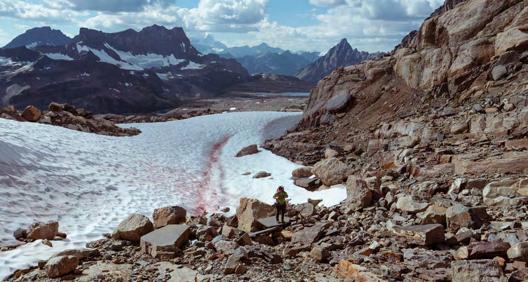

I joined ESS as faculty in Fall 2022, but from 2013-2019 I was a graduate student in the department. During my time as a student, I greatly appreciated the supportive community, breadth of expertise, and the collaborative culture within the department, and so naturally I was thrilled to have the opportunity to return to ESS as faculty!
My research explores the evolution of rocky planets, with a particular emphasis on questions related to what makes planets habitable, and how we might detect life elsewhere. I apply computational models to solar system bodies, the early Earth, and rocky exoplanets to develop a more robust understanding of planetary evolution and better interpret potential biosignatures. While I am primarily a theorist, my model calculations are closely tied to what is (or will soon be) observable with space telescopes and solar system missions. I was drawn to astrobiology as a discipline because the question of whether there’s life beyond Earth is unique in that it is both incredibly profound and answerable in our lifetimes.
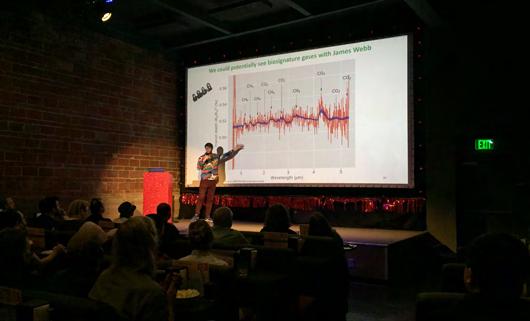

This spring I taught a new graduate seminar course on the connections between solar system exploration and exoplanet science. I’m looking forward to creating a new planetary physics and chemistry course for upper-level undergraduates, as well as contributing to introductory courses on planetary science, space exploration, and astrobiology. In the longer term, I also hope to develop a course that provides a planetary perspective on the Anthropocene and the evolution of the Earth system.
My near-term research goals involve applying computational models to interpret ongoing James Webb Space Telescope observations of rocky exoplanets and prepare for upcoming Venus missions. In teaching, I am looking forward to developing a robust planetary science curriculum in collaboration with other ESS faculty. More
broadly, I am excited to help cultivate a flourishing and inclusive planetary science community in ESS!
Outside of work, I mostly invest free time in connecting with friends and family, especially since the last few years have been so socially isolating. But I also enjoy noodling on the piano, binging on feel-good comedies, and, more recently, rediscovering the pacific northwest after having been away.
I will be joining ESS in September 2023. I’ve admired the work of many petrologists and volcanologists from UW, and the opportunity to join a department with such a strong history in my field is very special. I’m also excited by the collegial culture in ESS, and the department’s commitment to supporting early career scientists.

My research focuses on how magmas form and evolve beneath volcanoes. I am especially fascinated by how volatile elements like water, sulfur, and carbon influence the evolution of magmatic systems. While these elements are present in small quantities, they strongly impact how and when volcanoes erupt, the growth of Earth’s continents, and Earth’s longterm climate evolution.
I enjoy the challenges and rewards of using small features- chips of volcanic glass, individual crystals, tiny fluid inclusions- to learn more about these very big processes. I look forward to teaching coursework in igneous petrology, volcanology, and my own specialty area of volatile element behavior in volcanic systems.


My goal at ESS will be to help students obtain and nurture an appreciation for the beauty and significance of magmatic processes. This includes building a lab where we can continue discovering new things about these topics! Outside of work, I enjoy soaking up nature, cooking new foods, and reading.


I join ESS in November 2023. I’ll be making the move from Frankfurt, Germany, where I am currently finishing up a two-year postdoc as a Marie Curie fellow. I look forward to being part of a strong department known for its collegiality, with world-class colleagues and talented students.

I appreciate the opportunity to do cutting-edge research and attract top-flight graduate students in a supportive community. Connections across the University of Washington—like the Astrobiology Program or research links with Oceanography— only enhance the appeal. On the personal side, my husband is a Tacoma native: his parents met as grad students at the UW and his sister is a current undergraduate in public health. These local connections, together with the research possibilities, make ESS, UW, and Seattle an exceptional place to build my research program. I can’t wait to set down roots.
My research focuses on using the records of time and environment stored in sedimentary rocks to understand how Earth and life have changed together through Earth history. Every research project of mine begins in the field with observations of rocks or sediment. This has taken me all over the world!
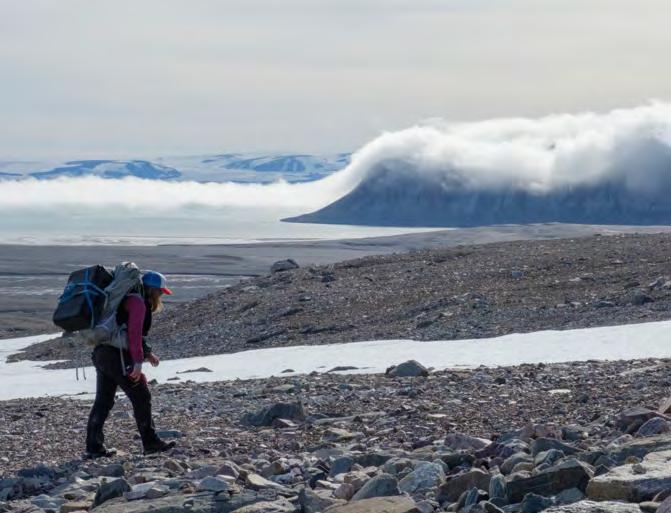
The field sites I am currently working in or plan to start working in soon are in Namibia, the Caribbean, and Newfoundland. Once I have samples and observations from the field, I characterize my samples in the lab using a range of techniques, from careful visual description to chemical characterization. I often apply techniques to directly measure the ages of rocks using radioactive isotopes. An accurate grasp of the ages of rocks and the records that they contain is critical for understanding rates of change and cause-andeffect relationships in Earth’s long history.
Much of my recent work focuses on the time period when early animals first appeared in the fossil record. My current research pushes emerging techniques to directly date carbonate rocks forward. These techniques have the potential to transform our understanding of Earth history by directly constraining the rates of change in otherwise poorly dated records.
At ESS, I am excited to teach a range of classes on sedimentary rocks, geochemical techniques, geobiology, and geochronology. My approach in the classroom focuses on building student ability and confidence through grappling with real data and applying the same tools as working scientists and professionals. I want to equip my students with tools that empower them to make quantitative and careful observations of the world around them and allow them to make discoveries. Whether they work in the private or public sectors, or continue in scientific research, I know these skills will serve them well.
I join ESS in the Summer of 2023 and am a planetary scientist and experimental mineral physicist. My research focuses on the study of extraterrestrial water-rich environments in icy moons and exoplanets through the characterization of the physical properties of solids and liquids up to extreme pressures and temperatures. I use experimental techniques such as diamond anvil cells to study the thermodynamic and physical properties of planetary relevant materials up to pressures found deep in planetary interiors, beyond 100,000 atmospheres. I also use advanced numerical methods to describe the properties of materials and study the effect on planetary interiors.

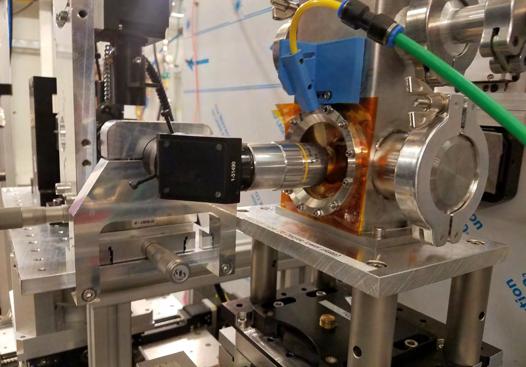

I currently teach ESS 102, an introductory class to planetary exploration and space travel where a large diversity of topics are covered (including planetary formation, orbital mechanics, rocket science, robotic and human spaceflight) to provide students with a solid general background on the current state and future of space exploration. I intervene in other classes in astrobiology, thermodynamics, geophysics and experimental sciences.
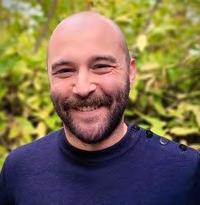

I joined ESS back in 2013 straight out of graduate school to become a research scientist with the Pacific Northwest Seismic Network. I will be starting as an Assistant Research Professor in Summer 2023.
When I joined ESS, the ShakeAlert project was ramping up and the PNSN was interested in developing a geodetic component to the system, which is what I focused on for my PhD. What drove me to the department was the freedom to work on any aspects of real-time geodesy and the welcoming attitude of everyone at the network. The thing that stands out most today is the critical mass of early career scientists that will be the heart of the department for the next few decades.

My research is focused on using geodetic data for studying an array of natural hazards, often in realtime. The thing that attracted me to the field, and I
think is a huge draw for students, is that there are real human impacts to the work we are doing. With early warning systems, the ability to save lives and reduce injuries is the primary objective. My primary goal, beyond raising enough money to support my lab, is to create a laboratory environment where everyone truly loves the work they are doing and feel well supported by myself and others.
I will most likely teach a geodetic methods course focused on GNSS technologies. Other potential courses I would like to teach are programming for geosciences and geophysical data analysis.
I have two young kids, so most of my time outside of work involves taking them to parks around the Seattle area. I also enjoy riding my e-bike to work, brewing beers, and urban exploration.
Hig (Bretwood Higman) is a geologist who lives in rural Alaska and runs the small nonprofit Ground Truth Alaska. He received a PhD in Earth and Space Sciences in 2007 from the University of Washington, Seattle where he studied the effects of the 2004 Indian Ocean tsunami. In the intervening years he’s been studying geologic hazards in Alaska, helping advocate for renewable energy, building trails, and trekking thousands of miles through wilderness with his family. Dr. Higman was the 2023 Research Gala Keynote Speaker. His talk discussed geohazard mitigation and climate uncertainty.

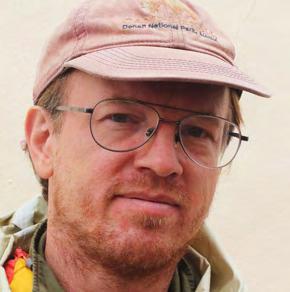
How did you end up in the field of geohazards?
I have had this fascination since I was a kid with disasters. In between undergrad and grad, around the time when I was applying for grad school, I volunteered with Brian Atwater doing field work down in the Columbia River. That was the first time actually working on applied geoscience and those kinds of problems, which were really interesting. And then I ended up having Jody Bourgeois as an advisor and maintained a close relationship with Brian. Once I started falling into that field, it felt really natural as a place to be with this kind of mix of interests. Until then, I was sort of bumbling about. It’s a good argument for doing a lot of different things.
While back at UW for the Gala, I’ve been thinking about grad students, and my experience as a grad student, and that the picture of pathways that I
had was pretty limited. What I ended up doing was following an unusual pathway. I’m not really advocating for that specific pathway. It’s worked out really well for me, but it is unusual.
Do you have any advice for current graduate students?
Some people say the PhD process is like a leaky pipeline, or a pyramid. There are only a few top level jobs and you need a bunch of grad school to get there. My objection to that idea is that I think we really want a lot of PhDs going off into society in other directions. It’s just amazing in life how different experiences connect together and open new opportunities, and in new ways to benefit those around you. And so I think that there are probably a lot of grad students still here that feel an intense pressure to take steps that will lead them into this high risk career path that is that leaky pipeline. It leaks because it gets smaller and you can’t fit all the grad students through so they start popping out the side. I think that society could use more members who have gone through some of the experiences of graduate school,
all throughout the system. I think that communities can benefit from the experience that someone has getting a PhD. If they’re community members who have gone through that, then that community benefits, whatever that community is.
I see science as a culture. It is a set of norms and institutions and ways that people interact. And I think bringing that culture of academics or scientists into that and becoming part of communities of all sorts around the world is really valuable. So in that way, the leaky pipeline may not be so bad. We need and want people jumping. In not pursuing a prestigious position somewhere, I’m leaving space out there. Fighting tooth and nail over these positions like a prestigious academic position, makes it harder for institutions that offer those positions to creatively embrace diversity.
Zoe obtained her B.S. in Environmental Science and a minor in Chemistry at the University of Rochester. She went on to obtain her Ph.D. in geomicrobiology and low-temperature aqueous geochemistry as Drew GormanLewis’s first graduate student. After completing three post-docs, she opened a business, Clear Horizons Consulting LLC, which has allowed her to embrace her ongoing work in California energy policy analysis, serve as an analytical chemist contractor for a startup battery recycling company, and provide consulting services in project development, grant seeking, and technical writing for non-profits in the Reno-Tahoe area. Going on four years as a small business owner, Zoe still gets to take on engaging and fulfilling challenges on a daily basis that include everything from critical assessments of quantitative model design and application, employee and contractor mentoring, program design, and business planning.
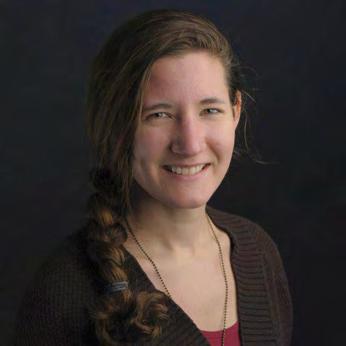
Todd’s research delves into impacts to the upper atmosphere and lower ionosphere by space and terrestrial drivers, as well as variations in global-scale atmospheric electrical current systems. Using data from the World Wide Lightning Location Network, Todd maps signatures of enhanced ionization from solar flares, radiation belt electron precipitation, and other space weather phenomena; which disrupt radio waves emitted by lightning. These events impact both human infrastructure – by disrupting radio communications – and upper atmosphere ozone chemistry, with potentially significant implications for space weather inputs to climate models. After graduation, Todd starts a postdoctoral research position at Los Alamos National Laboratory, where he will investigate the source of intense radio emissions within lightning channels, as well as opportunities to use these emissions for ionosphere remote sensing and radio communication diagnostics.

Anjali
Manoj, BSAnjali received her B.S. in Earth and Space Sciences with Departmental Honors concentrating in Geoscience with the Engineering Geology capstone and a minor in Data Science. She was a member of GeoClub where she helped in the club’s mission to create a community of students interested in Earth Sciences at UW. Anjali also served as the ESS Ambassador for the College of the Environment. She was involved in two research projects - one involving paleoclimate reconstruction from leaf fossils and another involving mapping alcoves on Mars. Both these projects were presented at various platforms. Anjali worked as a Lab and Outreach Assistant for the Pacific Northwest Seismic Network where she was part of various outreach efforts to raise awareness about Earthquake Risk and Preparedness in PNW communities After graduation, Anjali will be working as a geomorphologist focusing on river restoration projects for a consulting and engineering services firm.

Department of Earth and Space Sciences Class of 2023, Doctor of Philosophy

Department of Earth and Space Sciences Class of 2023, Master of Science

Department of Earth and Space Sciences Class of 2023, Bachelor of Science and Bachelor of Art
We will have a UW ESS Alumni Reception at the GSA Annual Meeting. Please look for us there. If you are an ESS alum, we’d love to know what you’re up to! Please send us your stories and updates to essdept@uw.edu.

Department of Earth and Space Sciences
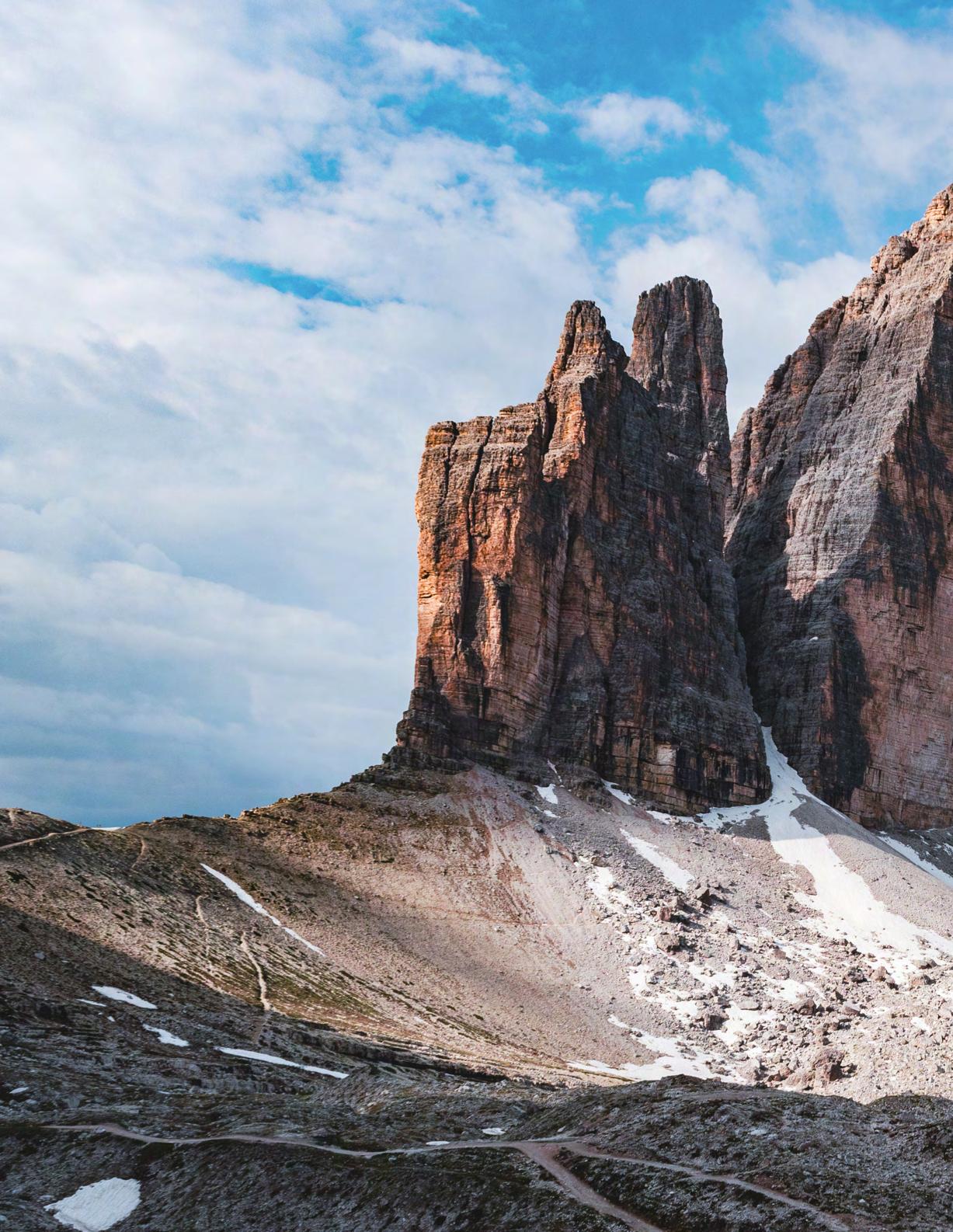
University of Washington
Johnson Hall Rm-070, Box 351310
4000 15th Avenue NE
Seattle, WA 98195-1310